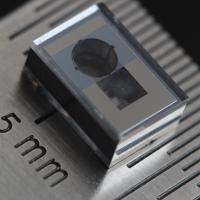Yb+ ion optical clock
Compact opital atomic clock based on trapped Yb+ ions (contact : Clément Lacroûte)
This project unites the Time and Frequeny (TF) and Micro Nano Science and Systems (MN2S) departments of FEMTO-ST. We are constructing a compact optical atomic clock based on trapped, ultra-cold Yb+ ions. The miniature ion trap will rely on micro-fabrication techniques that are well mastered at FEMTO-ST. The objective is to reach the 10-14 short-term stability range in a total volume of order 100 l.
Context
Today’s most accurate frequency standards are realized by optical atomic clocks, where an atomic reference (either a single trapped ion or a cloud of ultra-cold atoms) is used to stabilize a laser beam frequency. Laboratory setups have reached relative frequency accuracies below the 10-17 level, owed by the use of an optical transition frequency, a tremendous level of technical noise reduction and exquisite experimental control. There is an academic as well as industrial need for compact atomic clocks with good frequency stabilities: observatories, very-long baseline interferometry, particle accelerators, GPS, telecommunications, all require a stable frequency reference for timekeeping purposes. The current compact atomic clocks are liter-sized with a 10-12 at 1 s relative frequency stability, and the 10-13 level will soon be commercially available. There will be a strong need for even better clocks in the future, and research needs to be undertaken towards this goal. In particular, fundamental physics tests, geodesic measurements, time and frequency distribution for satellite networks would directly benefit from compact clocks with improved frequency stabilities.
Description of the project
We are currently designing and developing a compact optical atomic clock, aiming at a relative frequency stability of 10-14 or better in a volume of about 100 liters. These performances will be granted both by the use of laser-cooled ions, and by the very high (>1014 Hz) clock frequency. The experiment will be based on the trapping of Yb+ ions with a micro-fabricated circuit (“chip”). Surface electrodes (SE) will generate a trapping potential, localizing the ions a few hundreds of µm from the chip. The chip will be placed face-down on a glass cell pumped to ultra-high vacuum. The ions will be laser-cooled to a temperature of about 1 mK.
The project is conducted within the TF department of FEMTO-ST in Besançon. It benefits from its world-renowned expertise in the fields of metrology and MEMS and from interactions with PIA projects (Programme d’Investissements d’Avenir). The OSCILLATOR-IMP Equipex allows for phase-noise measurements of oscillators from MHz to optical frequencies. FEMTO-ST is also a kernel partner of the FIRST-TF Labex that coordinates the French TF metrology laboratories and their partners, increasing the TF projects visibility. The chip itself will be produced inside FEMTO-ST technologic central (MIMENTO), which features state-of-the-art microfabrication equipment. The chip design will benefit from the expertise of the Micro Nano Science and Systems (MN2S) department. The MITICC team also interacts with two major actors in the French ion trappers community, the CIML team in Marseille and the IPIQ team in Paris.
 For more details, please visit the project webpage here.
For more details, please visit the project webpage here.

